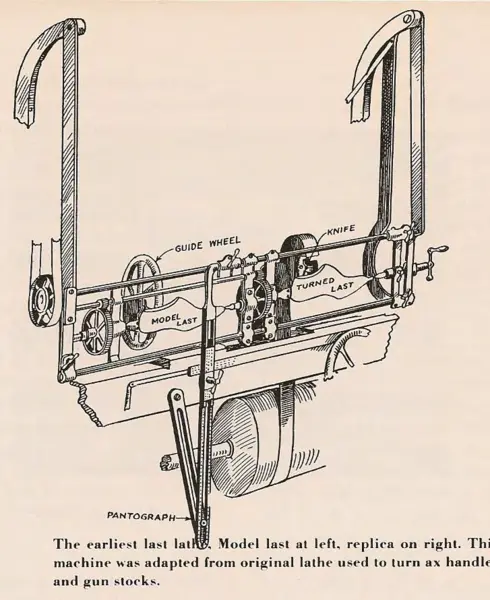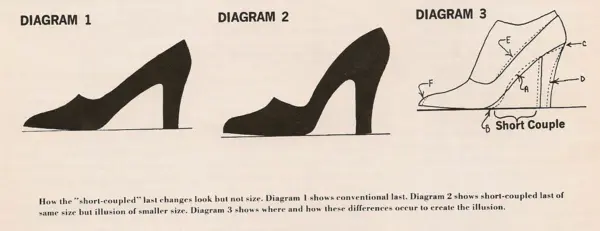a short book prepared for the 50th anniversary of the Sterling Last Corporation in 1982 about the history of shoemaking, lastmaking, and machinery
Notes
- really harps on fashion having been elitist before the 1920s
-
today the only lastmaking firm in the U.S. devoted exclusively to lastmaking.
- boasts repeatedly of being first to make a practical plastic last
A Brief History of Lastmaking
- moccasin first
- “stick to your last” from ancient Greek artist Apelles anecdote
- Thomas Beard and Isaac Rickman made their own lasts
- all lasts were straight
-
the first American craftsman on record to make lasts exclusively was William Young
- Blanchard Lathe
- Blanchard and Richard Richards formed first last factory in Lynn, later Goodwin Brothers
- 1840: one last for two sizes
-
placing a “standard” pad or shell over the cone or front of the last
-
known as fat and slim
- no widths
- straight lasts
-
-
Prior to the 1880s, there were only two types of lasts — one for boots and one for low-cut shoes. Each was again divided into two types, one for highgrade footwear, the another for all other footwear.
- explosive growth in 1860–1900
- “bin boy” to fetch lasts
- lefts and rights in US as early as 1807, but not quickly adopted
- faster to produce on straight lasts
- “The last shall be first.” was union motto
-
women workers were the last to be given their rightful working rights
- 1894: formation of Last Manufacturers Association of the U.S. in Boston
- one purpose to conform with new 1887 shoe last size standards
- beginning of modern last century in first decade of 20th century
- lefts and rights in Union Army shoes during Civil War, but mass adoption only at end of 19th century
- Edwin Simpson’s sizing system
-
manufacturers and retailers rebelled at first because it meant a substantial increase in inventory investment
-
The pinnacle of the last industry was reached in 1920 when six million pairs of lasts were produced by 45 firms with 60 lastmaking plants. Today there are only three lastmaking firms, and only one, Sterling, produces lasts exclusively.
- reasons for decline
- technology allows less time on the lasts
- plastic last lasts longer
-
massive invasion of footwear imports
The Evolution of Lastmaking Technology
-
Modern lastmaking is less than a century old.
- Thomas Blanchard
-
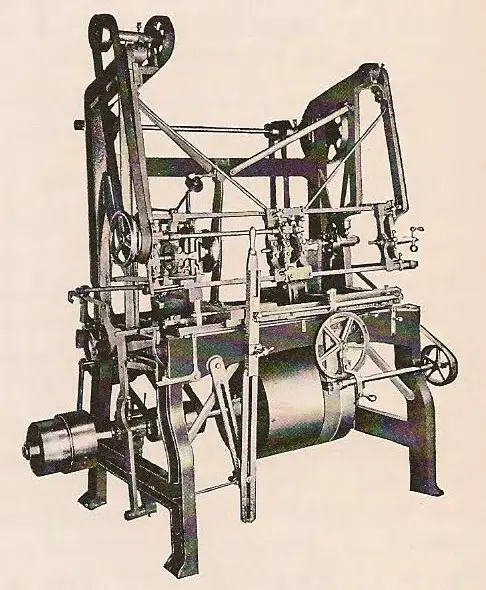
The Making of a Last
- “the most exciting part of a shoemaking, and also the most creative”
- overview of parts
- front cone and back cone
- toe spring “enables the shoe to ‘walk’ properly”
- “Each last must be designed with calculations in accord with a particular heel height. A last for a shoe with a 17/8 heel can’t be ‘adapted’ or used on a shoe with a 1/48 heel.”
- “A woman weighing 140 pounds and wearing a shoe with a 17/8 heel will bear more than one tone of weight on the bottom of the heel with each heel strike in walking.”
- “assure the proper tread”
- from Anglo-Saxon “laest”
- “unquestionaby the single most important and scientific element in shoemaking”
- “the lastmaker must know more about the shoe than does the shoe manufacturer or the designer of the shoe”
- work with stylists
- modelmaker to make sample last
-
Today, in 1982, development costs for the last manufacturer run upward of $250 to make each sample last, and the shoe manufacturer pays only a very small portion of this cost.
-
only about 10-15 percent of sample lasts actually go into final production
-
At any given time, an average shoe manufacturer will have between 5,500 and 6,000 pairs of different last styles, sizes and widths in stock.
-
while lasts cost appreciably more than 15 or 20 years ago, the actual “productivity” cost of lasts today is much lower.
-
much more “mileage” from his lasts than in years past
-
the short-coupled or shortback last, made for higher heels, that gives the shoe and foot a smaller-size look
- orthopedic lasts: “supinator”, “adductor”, “abductor”, “straight”, “inflare”, “outflare”
Last Nomenclature
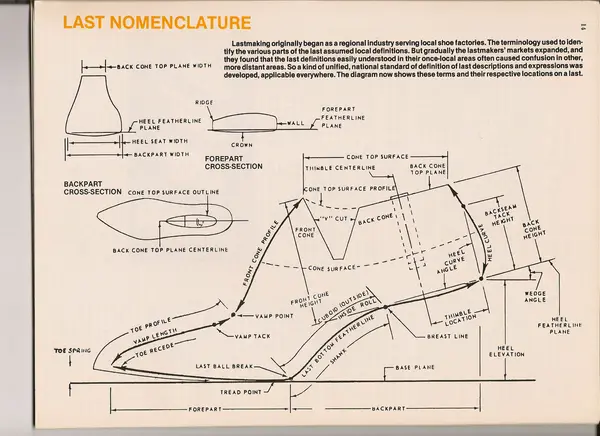
Parts shown: Back Cone, Backpart, Cone, Crown, Forepart, Front Cone, Ridge, V-Cut, Wall
Last Measurements shown: Back Cone Height, Back Cone Top Plane Width, Backpart Width, Backseam Tack Height, Front Cone Height, Heel Elevation, Heel Seat Width, Ridge, Toe Spring, Vamp Length
Lines shown: Back Cone Top Plane Centerline, Breast Line, Ridge, Thimble Centerline
Angles shown: Wedge Angle
Planes shown: Back Cone Top Plane, Base Plane, Forepart Featherline Plane, Heel Featherline Plane
Points shown: Last Ball Break, Tread Point, Vamp Point
The Last, The Sizes, The Fit
-
the last isn’t the last word in fit
- two fitting measurements versus 35 by lastmaker
- US shoe sizing less than 100 years old
- shoes once came in small, medium large, fat and slim
- legend of King Edward II intorducing shoe sizing in 1324
-
The whole thing is a myth.
- similar measurements back to 7th century
-
- minimum of ten years to learn model making
- basic measurements:
-
up until about 1900 almost all shoes were made on “straight” lasts, no lefts and rights
-
While lefts and rights in shoes have been traced back as far as 3,000 years, they were worn only by a few members of the nobility or aristocracy. For all others it was the straight last.
- Civil War: foot problems on long marches
- took about 30 more years after the war
-
Edwin B. Simpson sizing system
- “monumental piece of work”
- lengths and widths
- men’s, women’s, and children’s
- girth measurements for instep, waist, and ball for lastmakers
- not officially adopted until 1887
- took another 25 years for industry to convert
-
Today that same system is in use with some minor variations.
- American firsts:
- commercial scale left and rights
- half sizes
- widths
- ball, waist, instep, heel, heel-to-ball measures
- model size lasts
- decade ago: women 4B, men 7C
- today: women 6B, men 8D
-
The Mystery of Inner Space
- “shoemen”
- same inner volume: 9B, 9½, 10AA, 8½C, 8D
- distribution of volume differs
- proportional differences
- heel curve: hold foot but not bite Achilles
-
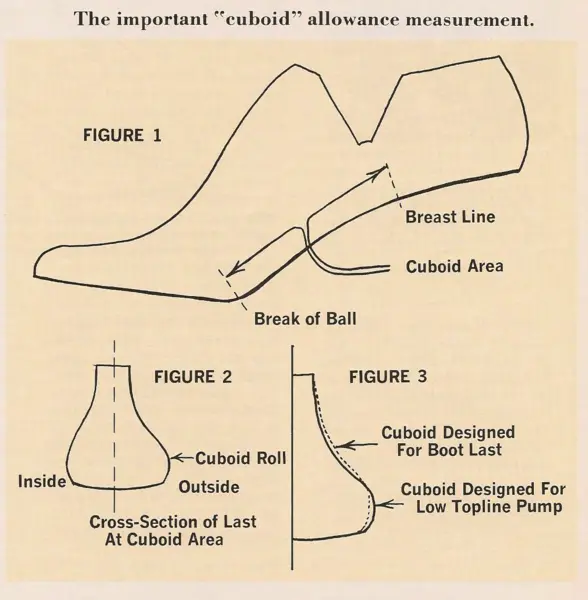
The Evolution of American Footwear Fashion
-
almost all of these innovative footwear fashions were an exclusive choice of the aristocracy, or those of wealth
-
Today, fashion is available to all, affordable for all.
-
up until 60 years ago “volume” fashion in America was almost non-existent
-
fashion for the thin upper crust, and utility shoes for most of the rest
-
“high” fashion
-
Elitist Fashion
-
up until 25 years ago all new footwear (and clothing) fashions were started by the upper-level social and moneyed class
-
long history of elitism, of social exclusivity
- sumptuary laws
- ornamentation: buckles, bows, etc.
- Cleopatra: tiny snakes
- $100,000 jeweled buckles
- Galerie des Modes
- Gody’s Lady’s Book
-
Up until 25 or 30 years ago, incidentally, the same could be said [that they were for the high-class and wealthy] of magazines like Vogue or Harper’s Bazaar.
-
The real world fashion revolution started in America in the early 1920s.
- “flapper”: left buckled overshoes unbuckled, so they flapped around
- “babydoll lasts”
-
“novelty” shoes
- birth of chain shoe stores selling women’s volume shoes
-
Up to about 1920, men traditionally wore plain dress boots in winter, low-cuts in spring-summer.
-
Around 1923, men began switching to low-cuts for year-round wear. But they also wore spats or gaiters with these shoes in winter, and linen spats in summer…
- aside: sumptuary laws limiting high heels to aristocracy
- impetus
- beginning of Prohibition
- “the sudden emancipation of women”
The first gave rise to rebellion, the second to freedom.
-
Break from Bondage
- . impetus
- beginning of Prohibition
- “the sudden emancipation of women”
The first gave rise to rebellion, the second to freedom.
-
Today, in the 1980s, an estimated 200,000 “new” footwear fashions are introduced each year in the U.S….
- “reasonably predictable cycles”
- cycles used to be longer and slower
-
the chief shift in footwear fashion has always begun with shapes
- broad or pointed toes
- heel heights
-
Over the past 60 years these cycles have occurred about every 8 or 9 years.
-
All fashion begins with shape, and all shape begins with the last.
- shoe shows
- problem: markdowns and closeouts from rapidly changing fashions
-
The shoe designers, for the first time, began to acquire important status in the industry because they were the key to success of the new lines.
- lastmakers become more important
-
Up to the 1920s most lasts were pretty much “basic” types.
-
Today, lastmakers are the prime explorers of footwear fashion.
- no straight lines on a last
- great era: 1930s-1960s
-
the reign of the Designer Shoe Guild
- Aside: “All Shoe Styles Based On Only 7 Basic Designs”
- listed
- oxford
- pump
- sandal
- boot
- mule
- clog
- moccasin
-
There has never been a basic shoe design created by or for a woman.
-
…all women’s shoes or styles are adaptations of men’s
- listed
The American Shoe Industry — A Brief History
TODO
Profile of Karl G. Kropf
- “Coutourier”
- “Fashion Createur”
- in charge of model room in New York
- 4-year apprenticeship as wood pattern maker
- 3-year apprenticeship as last and heel model maker (Bally)
- University of Bern for foot anatomy and orthopedics
- Miller Last
- Limoges
- Bally
- Sterling St. Louis plant model maker
- past ten years in New York
